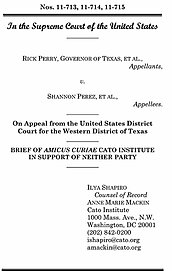Perry v. Perez
Learn more about Cato’s Amicus Briefs Program.
The decennial redrawing of electoral districts consistently produces extensive litigation. The most notable cases this cycle come, as they often have, from Texas. A number of activist groups challenged the Texas legislature’s maps for state house, state senate, and congressional districts, alleging racial discrimination under Section 2 of the Voting Rights Act in a special three-judge federal district court in San Antonio. At the same time, Texas is seeking in another three-judge district court in D.C. the “preclearance” of its maps that it needs to implement them under the VRA’s Section 5. Enacted in 1965 to combat pervasive discrimination against black voters in the South, the VRA has exceeded expectations in excising that shameful phenomenon. Its application now, however, stymies the orderly implementation of free and fair elections, particularly in jurisdictions subject not only to the general prohibition on race-based voter discrimination, but also the Section 5 preclearance requirement. Originally conceived as a check on states where discrimination was prevalent in the 1960s, preclearance requires certain jurisdictions to obtain federal approval before changing any election laws. (The Section 5 list is bizarre: six of the eleven states of the Old Confederacy — and certain counties in three others — plus Alaska, Arizona, and some counties or townships in five other states as diverse as New Hampshire and South Dakota. Curiously, (only) three New York counties are covered, all boroughs in New York City. What is going on in the Bronx, Brooklyn, and Manhattan that is not in Queens or Staten Island?) To obtain preclearance, proposed changes may not result in “retrogression,” a reduction in minority voters’ ability to elect their “preferred” candidates. Section 5 was originally a valuable tool in the fight against systemic disenfranchisement, but now facilitates the very discrimination it was designed to prevent. Indeed, the prohibition on retrogression effectively requires districting that assures that minority voters are the majority in a set number of districts — an inherently race-conscious mandate. The law, most recently renewed in 2006 for another 25 years, is based on deeply flawed assumptions and outdated statistical triggers, and flies in the face of the Fifteenth Amendment’s requirement that all voters be treated equally. In any event, because the D.C. court here had not yet ruled on preclearance, the San Antonio court felt obligated to draw “interim” maps for use pending final adjudication of both the Section 2 and 5 cases. Texas filed an emergency appeal with the Supreme Court, arguing that the lower court insufficiently deferred to the Texas legislature’s maps. Now on an expedited briefing and argument schedule, Cato filed an amicus brief supporting neither side and arguing that this case demonstrates all that is wrong with the VRA as it currently exists — highlighting the tension between the VRA and the Constitution and the practical difficulties that conflict engenders for election administration. Put simply, the VRA’s success has undermined its continuing viability; courts and legislatures struggle mightily and often fruitlessly to satisfy both the VRA’s race-based mandate and the Fifteenth Amendment’s equal treatment guarantee. We also point out that Section 5’s selective applicability precludes the establishment of nationwide districting standards, confounding lower courts and producing different, often contradictory, treatment of voting rights in different states — in large part because Sections 2 and 5 themselves conflict with each other. We note that regardless of the outcome of this litigation, it is unlikely that Texas will have fully legal electoral maps in time to administer the 2012 elections in a fair and efficient manner. These difficulties — constitutional, statutory, and practical — disadvantage candidates, voters, legislatures, and courts, and undermine the VRA’s great legacy of vindicating the voting rights of all citizens. The Court should thus schedule this case for broader reargument on the constitutionality of the Voting Rights Act as presently conceived.

This work is licensed under a Creative Commons Attribution-NonCommercial-ShareAlike 4.0 International License.
